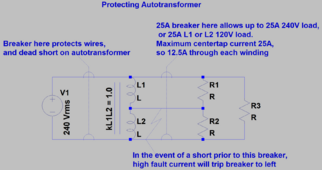Maybe the difference is circuit topology.
I've been saying 12.5A 2-pole breaker feeding autotransformer + loads was necessary to protect it. (e.g. only the 2-pole breaker on left of this drawing.) that's
upstream breaker.
What I just realized is, if we feed the autotransformer only with 240V from source, then daisy chain off its L1/L2 to a sub-panel with backfed 25A transformer, and also connect centertap of transformer to neutral bus of that panel, then autotransformer is protected. Current drawn from that panel will always have |N| = |L1 - L2|, Neither L1 nor L2 can exceed 25A so N can't exceed 25A. That allows loads to be 25A 120V on L1, or 25A 120V on L2, or 25A 240V on L1 & L2. that's
downstream breaker.
While it doesn't let you run loads willy-nilly like the Victron transformer with 100A pass-through breaker, it is probably good enough for most DIY work.
View attachment 208294
 I'll report back with numbers, pictures..... and idk what else. But all the data that I can easily and quickly provide!
I'll report back with numbers, pictures..... and idk what else. But all the data that I can easily and quickly provide!



